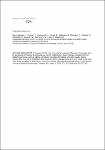Legionella oakridgensis ATCC 33761 genome sequence and phenotypic characterization reveals its replication capacity in amoebae
Brzuszkiewicz, Elzbieta
Schulz, Tino
Rydzewski, Kerstin
Daniel, Rolf
Gillmaier, Nadine
Dittmann, Christine
Holland, Gudrun
Schunder, Eva
Lautner, Monika
Eisenreich, Wolfgang
Lück, Christian
Heuner, Klaus
Legionella oakridgensis is able to cause Legionnaires’ disease, but is less virulent compared to L. pneumophila strains and very rarely associated with human disease. L. oakridgensis is the only species of the family legionellae which is able to grow on media without additional cysteine. In contrast to earlier publications, we found that L. oakridgensis is able to multiply in amoebae. We sequenced the genome of L. oakridgensis type strain OR-10 (ATCC 33761). The genome is smaller than the other yet sequenced Legionella genomes and has a higher G + C-content of 40.9%. L. oakridgensis lacks a flagellum and it also lacks all genes of the flagellar regulon except of the alternative sigma-28 factor FliA and the anti-sigma-28 factor FlgM. Genes encoding structural components of type I, type II, type IV Lvh and type IV Dot/Icm, Sec- and Tat-secretion systems could be identified. Only a limited set of Dot/Icm effector proteins have been recognized within the genome sequence of L. oakridgensis. Like in L. pneumophila strains, various proteins with eukaryotic motifs and eukaryote-like proteins were detected. We could demonstrate that the Dot/Icm system is essential for intracellular replication of L. oakridgensis. Furthermore, we identified new putative virulence factors of Legionella.
Dateien zu dieser Publikation
Keine Lizenzangabe

